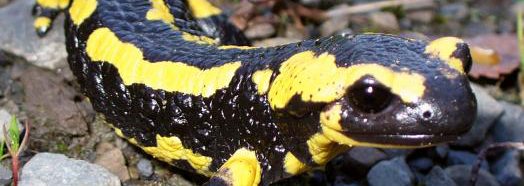Physical adaptation is usually thought of as a very slow process. It might take a species of bird several generations to evolve a beak suited for eating fruit compared to, say, pecking wood. This change would involve the death of several birds with “incorrect” sets of genes and the survival of one type of bird with a “correct” set of genes. But what if a creature had a huge library of genes, so that they might bypass natural selection by simply expressing the right genes for their environment? That’s what researchers at Washington University at St. Louis have found occurs in the versatile fire salamander.

The fire salamander, Salamandra infraimmaculata, makes its home on hot, dry mountaintops in the Middle East. However, it is also known to live in the forests of Germany, where temperatures frequently approach freezing. The salamander’s somewhat paradoxical habitat choices are made possible by expressing genes suited for arid weather in one location and expressing hardier genes when in another.
This is a hard concept to grasp at first because humans express all the genes they have. Salamanders express about the same amount of genes as humans, but actually have many more in their DNA than we do.
 (Fire Salamander photos courtesy of Wikimedia Commons, Steffen Häuser, Juan Lacruz, and Leigh Harries, respectively)
(Fire Salamander photos courtesy of Wikimedia Commons, Steffen Häuser, Juan Lacruz, and Leigh Harries, respectively)
“[T]hese species haven’t been looked at very much at the DNA level because their genome is much bigger than the human genome,” says WUSTL biologist Alan Templeton, PhD. Templeton studies how the fire salamanders, whose gene count is indeed fixed (albeit large), “turn genes on or off in a coordinated fashion in response to environmental cues.” These alternating patterns of gene expressions are known as transcriptomes.
 Salamanders’ transcriptomes can play a role in their maturation as well. If the water level drops in a pond of salamander tadpoles, they know that they will soon die unless they grow legs and lungs very quickly. So the tadpoles begin growing larger heads at an exponential rate; that is, the tadpole with the largest head will grow faster than his brothers. Why is this important? Templeton delivers the punch line in a WUSTL article:
Salamanders’ transcriptomes can play a role in their maturation as well. If the water level drops in a pond of salamander tadpoles, they know that they will soon die unless they grow legs and lungs very quickly. So the tadpoles begin growing larger heads at an exponential rate; that is, the tadpole with the largest head will grow faster than his brothers. Why is this important? Templeton delivers the punch line in a WUSTL article:
“The largest larva gets the biggest head so he can eat up all the smaller larvae to fuel his own metamorphosis. It’s called a cannibal morph.”
So the salamanders use their transcriptomes to work together in an unexpected way that admittedly furthers their survival. Templeton and his colleagues have received a $2 million grant from the Deutsch-Israel Project to continue studying these creatures and the greater implications of their transcriptomes. To read more about the funding of research at Washington University at St. Louis, check out our WUSTL Funding Stats Report:
Biotechnology Calendar, Inc. holds our St. Louis BioResearch Product Faire™ event on the WUSTL campus ever year. This show is an excellent opportunity for life science scientists and laboratory equipment suppliers to network and discuss their research needs and solutions. To see our complete 2013 show schedule, click here.


